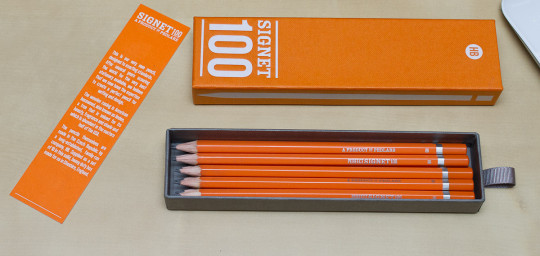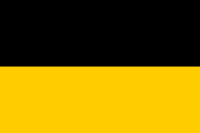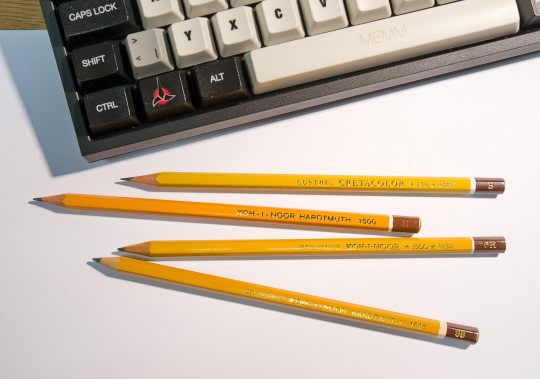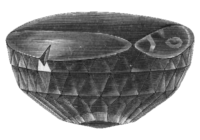Pedlar’s Signet 100 HB
Earlier this year, it was in February, Pedlars contacted me asking for some suggestions what pencils to add to their current offering. I believe Palimpsest suggested that they should contact me – and to be quite honest, I was quite excited to have a chance to make a (small) difference in the world of pencils. In my first email back I mentioned, among other pencils, the Kimberly – a pencil I really like, not only because of its metal cap and the fact that it’s made in the USA. Luckily Sean was kind enough to send me a pack a few years ago. Off topic: To my surprise the General Pencil Co seems to label their products, among other languages, in German, even though I’ve never seen their products in Germany – but it shows that exporting this pencil is an option they had in mind.

Much later did I found out by coincidence that Pedlars seemed to have liked my suggestion and started to actually add the Kimberly to their line of pencils. I’m very glad they did!
Pedlar’s own pencil, the Signet 100
End of November I heard from Pedlars again. This time they sent me a new pencil they’re selling, their own model, called the Signet 100. According to the description in the box the pencil is made using American basswood/linden [1]Lexikaliker thought the Czech made Stabilo EasyGraph might possibly also be made using linden wood. and is made in the Czech Republic. The box it comes in, a very nice box with an old fashioned surface that implies quality is made in Cheshire.
Where is it made?
I only know of two pencil factories in the Czech Republic. The Stabilo-Schwan factory is Český Krumlov and the Koh-I-Noor L. & C. Hardtmuth factory in Budweis. To be honest, my guess would have been that the Signet pencils are made by Koh-I-Noor L. & C. Hardtmuth, but according to the Signet box they are “made in the Czeck Republic by a long-established, family run company”, which means we can probably rule out Koh-I-Noor as the manufacturer.
Koh-I-Noor’s official name is Koh-I-Noor Hardtmuth a.s. and the company is a member of the Koh-I-Noor holding a.s. Group – and a.s. means that a company is a joint stock company, which makes an a.s. company not impossible, but less likely to be a family-run company. Stabilo Schwan is a limited company, so more likely to be seen as a family-run company, but there might very well be other pencil manufacturers in the Czech Republic. If you know of any, please let me know.
The pencil
The first impression I had when looking at the Signet was that it looks quite similar to the Palomino, which was also sold by Pedlars, so whoever might have designed the pencil might have gotten some inspiration (maybe subconscious, or maybe this is a coincidence), by Pedlar’s current range.

Comparing this pencil in my mind to the recently discussed Koh-I-Noor, despite it being unlikely it’s from the same factory (‘family-run company’), I expected it to be a light writer, but it isn’t. There are smoother pencils out there, including many cheaper pencils (for example the really good and great value John Lewis pencils, the more I use them, the more I like them, but performance is good. Point retention is good, too, i.e. the point doesn’t wear down too fast. The pencil also doesn’t smudge and is easy to eraser.

The main issue with this pencil is probably the price, £24.95 (~$39; €31.50) for ten pencils. You do get a nice cardboard box with these pencils, but the price makes you compare this pencil to other high end pencils …where it can’t really compete and it therefore looks like a niche / hipster product.
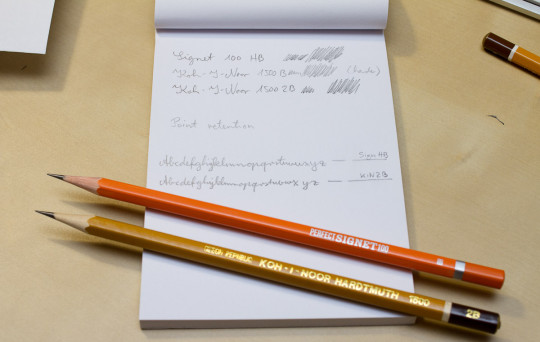
Price and exchange rates: December 2014
You can find Palimpsest’s review of the Signet on her blog.
I would like to thank Ms Karie from Pedlar’s for the Signet pencils, which I have received for free.
References
| ↑1 | Lexikaliker thought the Czech made Stabilo EasyGraph might possibly also be made using linden wood. |
|---|
Pedlar’s Signet 100 HB Read More »



